The Harvest Moon Hosts Rays and Maria, and the Equinox Announces Northern Autumn!
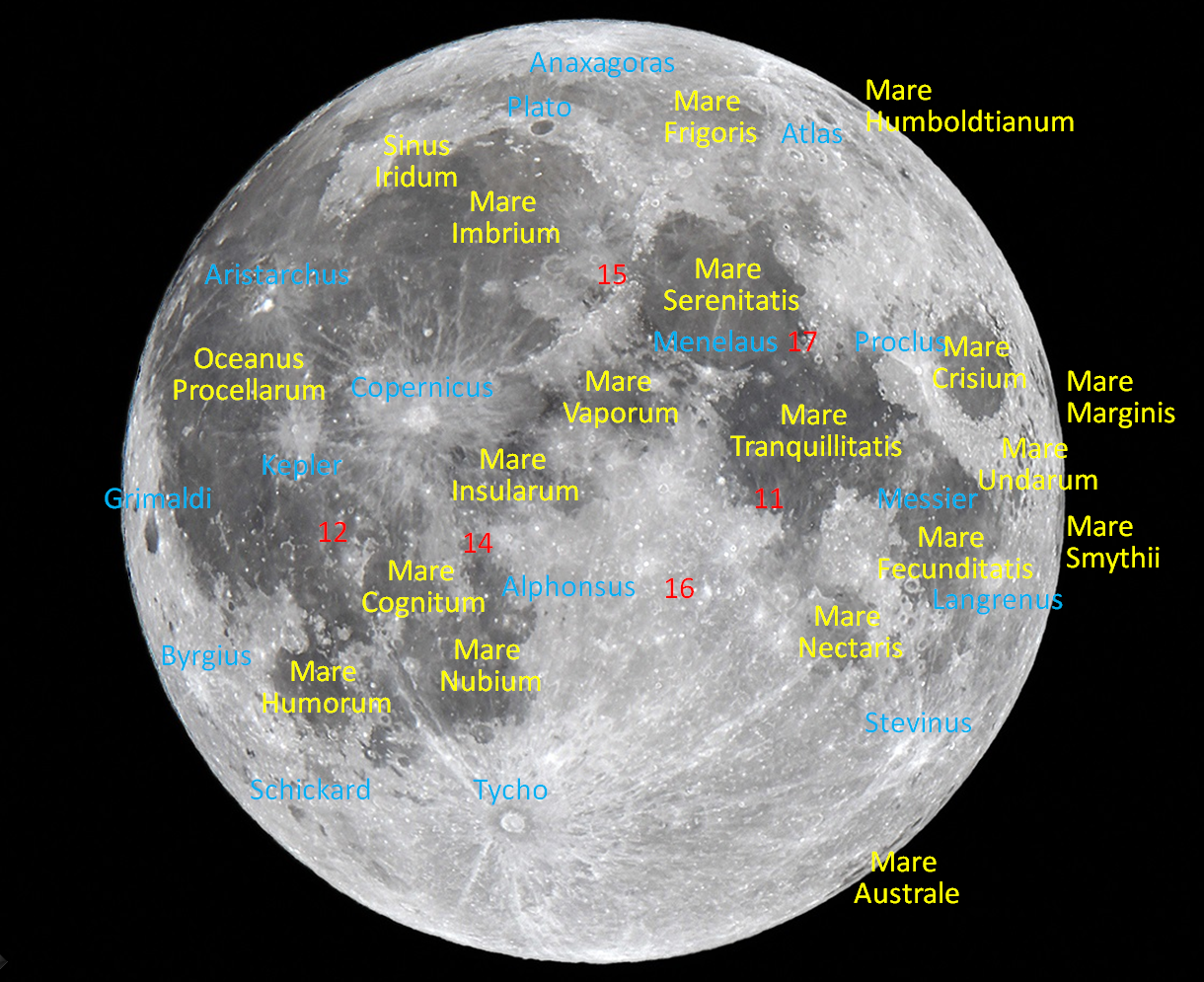
I’ve annotated this image of the full moon taken by Michael Watson of Toronto. The dark maria are labelled in yellow with their Latin names. Major craters and those with ray systems are in blue. the red numerals show the Apollo landing sites, although the equipment is not visible from Earth.
Hello, Autumn Harvest Stargazers!
Here are your Astronomy Skylights for the week of September 19th, 2021 by Chris Vaughan. Feel free to pass this along to your friends and send me your comments, questions, and suggested topics.You can also follow me on Twitter as @astrogeoguy! Unless otherwise noted, all times are expressed in Eastern Time. To subscribe to these emails please click this MailChimp link.
I can bring my Digital Starlab portable inflatable planetarium to your school or other daytime or evening event, or teach a session online. Contact me through AstroGeo.ca, and we’ll tour the Universe, or the Earth’s interior, together! My terrific new book with John A. Read titled 110 Things to See With a Telescope (in paperback and hardcover) is a guide to viewing the deep sky objects in the Messier List – for both beginners and seasoned astronomers.
Nights during the first half of this week will be flooded by bright moonlight from the Harvest Moon, but there is plenty to see on it, including rays systems and dark maria. The September equinox will arrive at mid-week. Meanwhile, the bright planets Venus, Jupiter, and Saturn shine in evening! Read on for your Skylights!
Autumn in the North Begins!
At 3:21 pm Eastern Daylight Time on Wednesday, September 22, the September equinox will occur – kicking off autumn in the Northern Hemisphere. Here’s why…
As the Earth travels around the sun (completing one orbit every year), the sun moves continuously eastward through the fixed and distant background stars. The circular path it traces around the sky is called the ecliptic. The sun “re-traces its steps” every year on the same dates. (Because Earth’s orbit is close to the orbital planes of all the other planets, major Solar System bodies are always found near the ecliptic.)

The Earth’s axis of rotation is tilted 23.5° away from the ecliptic – so an imaginary circle painted on the sky directly overhead of our equator runs through a different group of stars. In fact, that celestial equator divides the celestial sphere into two great bowls, the Northern Hemisphere stars and the Southern Hemisphere stars. Since the Earth’s equator is due south for we observers in the Northern Hemisphere, the celestial equator is always in the southern part of our sky, and it runs from the eastern horizon to the western horizon.
You can think of the equator and ecliptic circles as two hula hoops sharing the same centre – us. Since one hoop is tilted by 23.5° compared to the other one, the two circles only intersect at two spots in the sky, one in western Virgo (the Maiden) and the other in western Pisces (the Fishes). The sun reaches those spots during the third weeks of March and September, respectively. Another way of thinking about it is that half of the ecliptic runs through stars in the southern celestial hemisphere, and the other half runs through northern stars – so the sun spends half of the year among northern stars and the other half among southern stars.
At the moment of an equinox, the sun is at one of the intersection points – as if it is “stepping over” the equator. The full disk of the sun takes about 13 hours to cross the equator – but we define the equinox as the precise moment when the centre of the sun slides across. This year that will occur at 3:21 pm EDT, or 19:21 Greenwich Mean Time. The equinoxes and solstices are global events. Just add or subtract the appropriate number of hours to determine when northern autumn will begin for your own time zone.
On the September, or autumnal, equinox the sun is passing into the southern bowl of the sky. Six months later, on the vernal equinox, it will cross the celestial equator at the other intersection point and re-enter the northern bowl of the sky. At that moment, spring will begin for the Northern Hemisphere. (I like to avoid using the seasonal terms “vernal” and “autumnal” because those seasons are swapped for people living in the Southern Hemisphere.) The solstices occur mid-way between the equinoxes – in June and December.
An equinox triggers several interesting effects. At either equinox, the sun rises due east and sets due west. For the six months following the September equinox, the sun will spend all of each day among the Southern Hemisphere stars, and climb high in the sky for the lucky folks who live there! The higher sun will take more daylight hours to cross the sky and will deliver more highly-concentrated solar radiation, producing warmer weather. (Compare the intensity of a flashlight’s light when it’s beamed straight at a wall versus obliquely at the wall. The bright circle of light gets weaker when it’s spread into an oval.) During the same months, North Americans, Europeans, and Asians have to accept shorter, colder days and longer nights (which are great for warmly dressed astronomers). On the day of the equinox, everyone on Earth experiences 12 hours each of day-time and night-time (unless you live near the North Pole where the sun won’t drop low enough below the horizon to darken the sky). This is where the term equinox, Latin for “equal night”, comes from.

The nights around the equinoxes offer a higher likelihood of the Northern Lights, or aurorae, at high northern and southern latitudes. Just as two bar magnets lined up with their poles in the same direction repel one another strongly, the Earth’s magnetic field repels the sun’s field. At the equinoxes, the Earth’s axis tilts partly sideways compared to the sun, so the two “magnets” aren’t lined up as well, reducing Earth’s ability to deflect the sun’s field and the charged particles that trigger aurorae in our upper atmosphere.
At this time in September every year, the Earth is travelling almost directly towards the stars that mark the upraised club of Orion (the Hunter) and the toes of Gemini (the Twins). In a few weeks, that geometry will produce the “bugs on a windshield” effect when the Orionids meteor shower particles strike the Earth’s upper atmosphere and produce the streaks of light we see. Also at this time, Earth is travelling almost directly away from the stars of Sagittarius (the Archer) and Ophiuchus (the Water-Bearer).
A final aside: The sun’s journey along the ecliptic produced the Zodiac. Early skywatchers noted that, in the course of one year, the sun passed through the same twelve (well, thirteen actually) constellations – avoiding all others. Those “special constellations” became the zodiac. It also crossed through the same zodiac constellation every year on the same range of dates – leading to the astrology that many follow to this day. At that time, the equinoxes were called the First Point of Aries and the First Point of Libra – because those constellations hosted the sun in March and September several thousand years ago. Over the centuries, the wobble of the Earth’s axis (precession) has caused the two equinox points to shift one zodiac constellation to the west.
The Moon
For the first few nights of this week, the moon will light up evening skies around the world from sunset to sunrise because its 3,475 km-wide globe will be positioned opposite the sun. The moon reflects only 13% of the sunlight that strikes it – about the same as a paved asphalt driveway – but that’s enough to read a book by, and to overwhelm all but the brightest stars. The sun’s light takes 8 minutes and 21 seconds to reach the Earth-moon duo. The sunlight bouncing off the moon requires another 1.3 seconds to cross the space between Luna and Terra, and tickle your retinas.
Tonight (Sunday) at the latitude of Toronto, Canada (43.8° N) the 99%-illuminated moon will rise at 7:22 pm local time. It will rise 40 minutes earlier for observers living along Earth’s equator. It will rise later as you travel north – until you reach 78° N, where it won’t rise at all. Use your binoculars or telescope to see that a thin strip along the right-hand edge of the moon (its western limb) remains dark. Tonight’s moon will shine among the stars of Aquarius (the Water-Bearer), and only a palm’s width from Neptune – but you won’t see those faint objects so close to the moon’s glare.
On Monday night at 7:54 pm EDT (or 23:54 Greenwich Mean Time), the moon will officially reach its full phase, when it will sit across the sky from the sun, in western Pisces (the Fishes). The September full moon, traditionally known as the “Corn Moon” and “Barley Moon”, always shines in or near the stars of Aquarius and Pisces. The indigenous Anishinaabe people of the Great Lakes region call this moon Waatebagaa-giizis or Waabaagbagaa-giizis, the “Leaves Turning Moon” or “Leaves Falling Moon”. The Cree Nation of central Canada calls the September full moon Nimitahamowipisim, the “Rutting Moon” – when the bull moose scrapes the velvet from his antlers as a sign that mating shall begin. The Haudenosaunee (Iroquois) of Eastern North America call it Seskehko-wa, the “Time of Much Freshness Moon”.
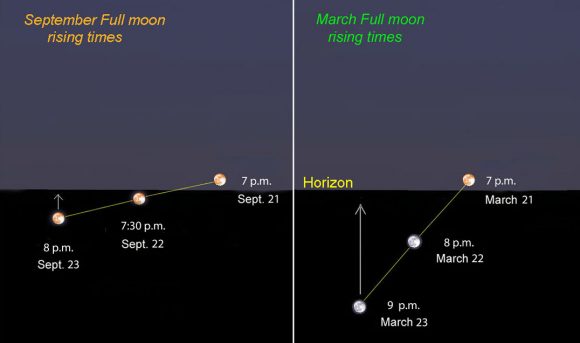
Because this is the closest full moon to the autumnal equinox in 2021, it is also the Harvest Moon. On the evenings around its full phase, the moon normally rises about 50 minutes later than the previous night. But the shallow slope of the evening ecliptic (and the moon’s orbit) around the equinox causes Harvest Moons to rise at almost the same time each night – only delayed by as little as 10 minutes, depending on your latitude. In the Toronto area, the delay is about 20 minutes.
The harvest moon phenomenon traditionally allowed farmers to work into the evening under bright moonlight – hence its name. It also means that if you arrive home from work or walk the dog at the same time every evening, you might notice the “full” moon for several days in a row. The effect is stronger the farther from the equator you live. The moon behaves the same way for Southern Hemisphere dwellers – only six months later, at their own autumnal equinox in March.
With no shadows anywhere, the light and dark areas on the full moon show where the different rock types occur on the moon’s surface. The bright areas are the ancient, heavily-cratered lunar highlands composed of crystalline anorthosite rock, and the dark areas are younger maria, iron-rich basalts that have filled the oldest deep basins and which have fewer craters. The nights around full are the best ones for seeing the bright ray systems that emanate from craters on the moon. Those patterns are material that was blasted out during the impact that formed the crater, and by the secondary impacts of excavated chunks of rock.
Due to the moon’s orbital inclination of 5 degrees from the ecliptic and its ellipticity, the moon tilts up-and-down and sways left-to-right by a small amount while keeping the same hemisphere pointed towards Earth at all times. Over the course of many months, this lunar libration effect lets us see 56% of the moon’s total surface from Earth. Those motions can be detected by noting the positions of major features near the limb of the moon. One of the best of these is dark and very round Mare Crisium, the “Sea of Crises”. The 556 km-wide basin is easy to see using your unaided eyes or binoculars – and in telescopes. It always sits in the northeastern quadrant of the moon – that’s the upper right for Northern Hemisphere observers (lunar east is the opposite of sky east).
At this week’s full moon, libration will pull Mare Crisium lower and more to the left (lunar west) than average, letting us see features on the moon that are normally hidden beyond the moon’s northeastern edge, such as the dark blotches of Mare Marginis “Sea of the Edge”, which lies directly east of Mare Crisium, and Mare Humboldtianum, which sits close to the moon’s upper left edge.
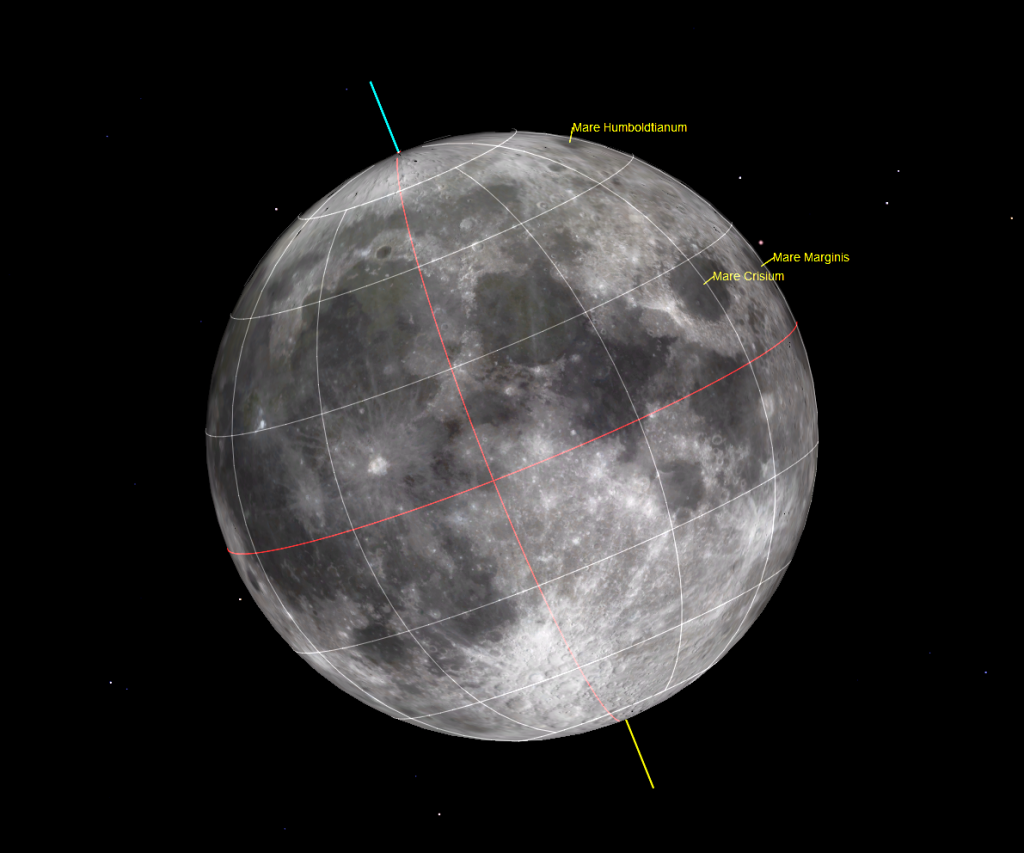
The dark maria (Latin for “seas”) cover about 16% of the moon’s surface area – but almost all of them are on the Earth-facing hemisphere, so they appear more numerous than they are. The names we use today for the major moon features were chosen by the Jesuit priest Giovanni Battista Riccioli in 1651 and published as a labeled map drawn by fellow Jesuit Francesco Maria Grimaldi. (Each of those gentlemen have a crater named for them.) Riccioli assigned water-themed names for many of the moon’s “seas”, and states of mind for others. Only two were named for people, Mare Humboldtianum for explorer Alexander von Humboldt and Mare Smythii for astronomer William Henry Smyth.
Starting below Mare Crisium, several of the maria link together to form a curving chain of darker rock across the northern half of the moon’s near-side. Mare Fecunditatis the “Sea of Fertility” is first. Mare Tranquillitatis, where humankind first walked upon the moon, is the large, round mare in the centre of the chain. Notice that this region is darker and bluer than the others, due to enrichment in the mineral titanium. That’s one of the reasons the first Apollo mission was sent there – geologists wanted to know why it was so different. Small Mare Nectaris, the “sea of Nectar” sits below them. At the left (western) end of the chain is large, smooth-edged Mare Serenitatis, the “Sea of Serenity”. All four form the hair of the Woman on the Moon, who I see as Wilma Flintstone facing to the left.
The western half of the moon’s disk is covered by large, irregular maria. In the north is Mare Imbrium, the “Sea of Showers”, which is ringed by mountains on the east. To the lower left of that is the giant Oceanus Procellarum, the “Ocean of Storms”. Devout Catholic Riccioli put the prominent craters Copernicus, Aristarchus, and Kepler in Oceanus Procellarum because those scientists were teaching the heliocentric model of the Solar System, counter to the church’s teachings. Three smaller maria named Mare Cognitum “Sea of Thinking”, Mare Humorum “Sea of Moisture”, and Mare Nubium “Sea of clouds” are clumped just left of the moon’s centre, below Wilma’s chin and above the bright crater Tycho, which forms her necklace!
Near the full moon phase, bright rays can be seen extending from the younger craters on the lunar near side. The impact that created very bright Tycho, which is located in the south-central area of the moon, threw out streaks of bright material that extend thousands of km in all directions across the moon’s near side. Another particularly interesting ray system surrounds the crater Proclus. The 28 km-wide crater and its ray system are visible in binoculars and telescopes, at the lower left edge of Mare Crisium. The Proclus rays, about 600 km in length, only show up on the eastern, right-hand side of the crater, and also within Mare Crisium, suggesting that the object that produced them arrived at a very shallow angle from the southwest. Scanning the moon with binoculars on the nights around full moon will reveal many, many ray systems!
From Tuesday through Thursday, the waning moon will rise late and travel through the stars adjoining Pisces and Cetus (the Whale). It’ll hop past Uranus in Aries (the Ram) on Thursday-Friday, and then end the week in Taurus (the Bull). By that time, the moon will be shining after midnight, and will sit high in the southern sky by dawn on Saturday and Sunday.
The Planets
This week Mercury will rapidly follow the sun down after sunset, making it too difficult to see unless you live near the equator. On Tuesday, southerly latitude skywatchers can also enjoy seeing Mercury pass only a thumb’s width below (or 1.4 degrees to the celestial south of) the bright star Spica. That is just close enough for them to share a low power eyepiece view, but telescopic views will be blurry because they are shining through so much of Earth’s distorting atmosphere. Mercury will re-appear in an excellent showing before dawn in late October.
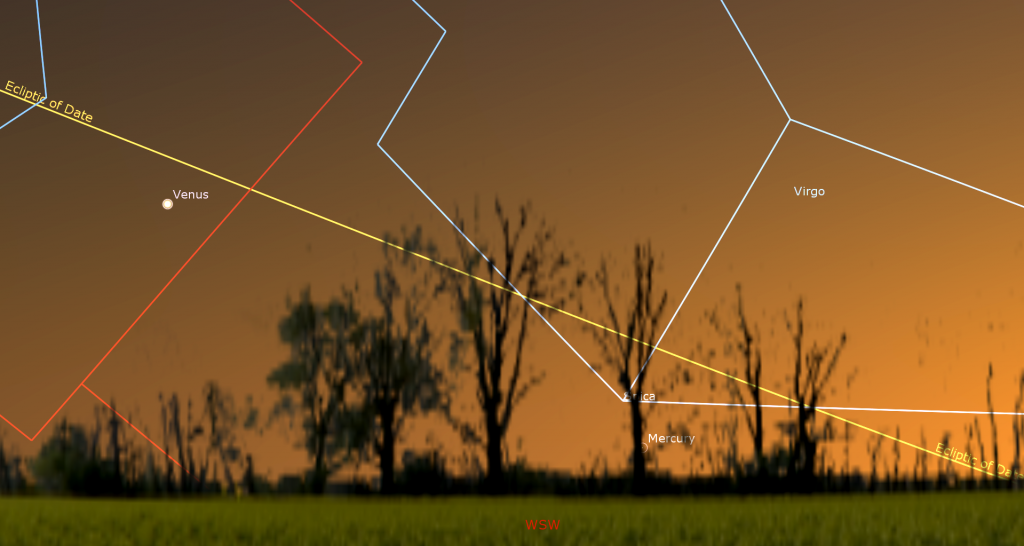
Extremely bright Venus will emerge from the post-sunset twilight by 7:30 pm local time and then set at about 8:45 pm. Venus will not be positioned much higher than the trees and rooftops, so you might need to walk around until you find an open view to the west-southwest.
Because the inner planets Mercury and Venus are closer to the sun than Earth, they show phases – just like the moon! When viewed in a backyard telescope Venus will exhibit a small, featureless, football-shaped disk because it’s only 65%-illuminated right now. It will grow in size and wane in phase every week. Aim your telescope at Venus as soon as you can spot the planet in the sky (but ensure that the sun has completely disappeared first). That way, Venus will be higher and shining through less distorting atmosphere – giving you a clearer view.
While Venus descends the darkening west-southwestern sky, one-third as bright Jupiter will be about as high in the southeast. By 8 pm local time, the yellowish dot of Saturn will become visible less than two fist diameters to Jupiter’s upper right (or 16° to the celestial west). The two gas giants will cross the night sky together amidst the faint stars of Capricornus (the Sea-Goat) and then set in the southwest during the wee hours. Sadly, for telescope owners, the low position of the ecliptic on September evenings is keeping those planets in the lower third of the sky, where their light must punch through two to three times as much of Earth’s distorting atmosphere – reducing their crispness. They’ll both look their best at about 10 pm local time, when they’ll be highest, 27° up in the southern sky.
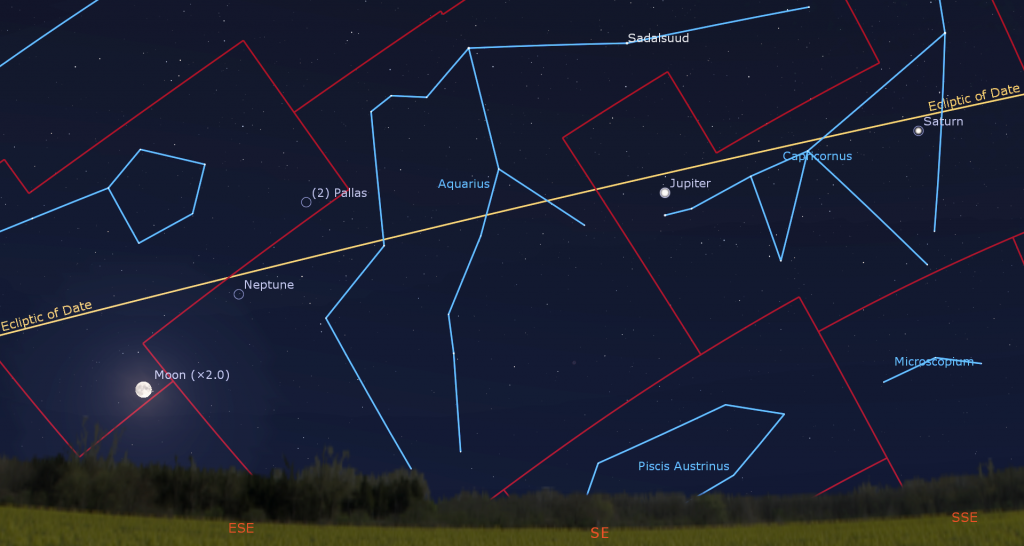
Saturn’s bright rings are thrilling to see in any telescope! The rings are about 2.4 times the diameter of Saturn’s globe. If your optics are good and the air is steady, try to see the Cassini Division, a narrow gap that separates the outer and inner rings. Look for a faint dark belt encircling the planet, too. Take long lingering looks through the eyepiece – so that you can catch moments of perfect atmospheric clarity.
From here on Earth, Saturn’s axial tilt of 26.7° lets us see the top of its ring plane, and allows its brighter moons to array themselves all around the planet. Saturn’s largest and brightest moon Titan never wanders more than five times the width of Saturn’s rings from the planet. Much fainter Iapetus can stray up to twelve times the ring width. Iapetus is dark on one hemisphere and bright on the other, so it looks dimmer when it is east of Saturn, and it looks brighter when it is west of Saturn (as it is this week). The next brightest moons Rhea, Dione, Tethys, Enceladus, and Mimas all stay within one ring width of Saturn.
During this week, Titan will migrate counter-clockwise around Saturn, moving from above (celestial north) the planet tonight to the lower left (celestial southeast) of Saturn next Sunday. (Remember that your telescope will probably flip the view around.) How many of the moons can you see in your telescope?
Binoculars and small telescopes will show you the Jupiter’s four large Galilean moons named Io, Europa, Callisto, and Ganymede. Since Jupiter’s axial tilt is a miniscule 3°, those moons always appear to be strung like beads along a straight line that passes through the planet, and parallel to Jupiter’s dark equatorial belts. That line tilts as Jupiter crosses the sky, and the moons’ arrangement varies from night to night.
For observers in the Eastern Time Zone with good telescopes, the Great Red Spot (or GRS) will be visible while it crosses Jupiter tonight (Sunday), Wednesday and Friday evening, and late on Tuesday and next Sunday night. It can also be observed during the wee hours on Friday and next Sunday morning.
From time to time, the small round black shadows cast by Jupiter’s Galilean moons become visible in amateur telescopes when they cross (or transit) the planet’s disk. Europa’s shadow will cross between 12:15 am and 3 am EDT on Monday. Io’s shadow will complete a crossing at 8:40 pm EDT.
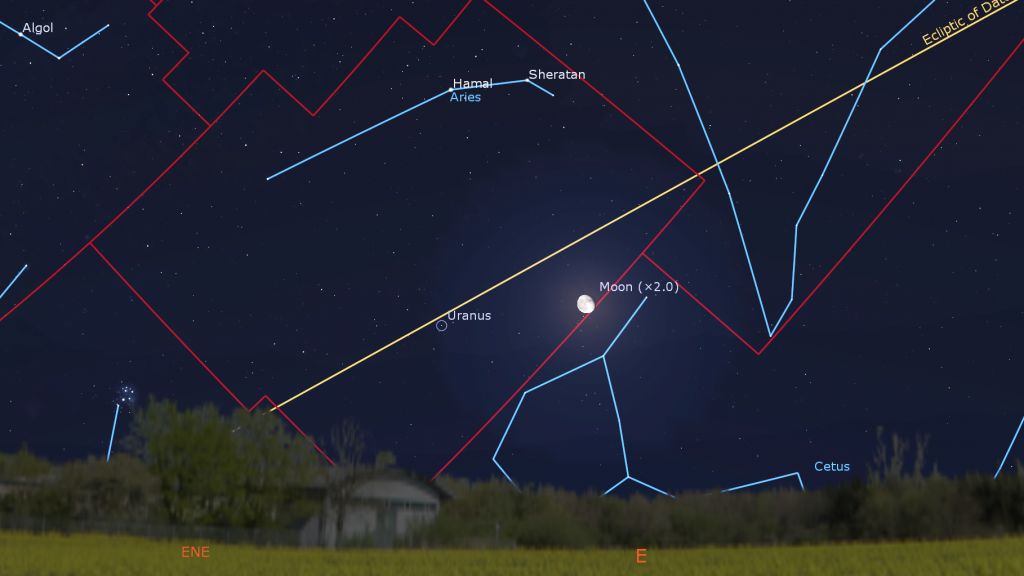
This week Magnitude 5.7 Uranus will be observable nearly all night after it rises around 9 pm local time. But wait until it has climbed higher in late evening to view it. Uranus is spending all of this year parked below Hamal and Sheratan, the two brightest stars in Aries (the Ram). The blue-green planet is currently surrounded by the moderately bright (5th magnitude) stars Sigma, Omicron, Rho, and Pi Arietis – creating a distinctive asterism for anyone viewing Uranus in binoculars. I recommend noting Uranus’ location and then seeking it out later this week, when the bright moon will have moved away from it.
Public Astro-Themed Events
Every Monday evening, York University’s Allan I. Carswell Observatory runs an online star party – broadcasting views from four telescopes/cameras, answering viewer questions, and taking requests! Details are here. Their in-person Wednesday night viewing has been converted to online via the observatory YouTube channel.
Don’t forget to take advantage of the astronomy-themed YouTube videos posted by RASC Toronto Centre and RASC Canada.
On Tuesday night, September 21 from 8 to 9 pm EDT, SkyNews Magazine editor Allendria Brunjes and Canadian astrophotographer Paul Owen will host Subs and Stars, a free, eight-part online series that teaches people how astrophotos are built and edited. In Lesson 1, they’ll cover software tools for processing deep-sky images. Details are here, and the registration link is here.
On Wednesday evening, September 22 at 7:30 pm EDT, the RASC Toronto Centre will live stream their monthly Speakers Night meeting. This month will feature Dr. Leo Yvonne Alcorn, Postdoctoral Fellow, Astronomy and Astrophysics, York University and The Dunlap Institute. Her talk is titled The Colour Out of Space and Other Tales of Cosmic Horror. Everyone is invited to watch the presentation live on the RASC Toronto Centre YouTube channel. Details are here. The RASC Toronto Centre has an archive of their past meetings and guest lectures on their YouTube Channel here.
On Friday, September 24 at 7:30 pm EDT, the RASC Mississauga Centre will live stream their Speakers Night featuring Dr. Laurie Rousseau-Nepton, a resident astronomer at the Canada-France-Hawaii Observatory. She was the first indigenous woman in Canada to obtain a PhD in astrophysics. Details are here.
Public sessions at the David Dunlap Observatory may not be running at the moment, but we are pleased to offer some virtual experiences instead in partnership with Richmond Hill. The modest fee supports RASC’s education and public outreach efforts at DDO. On Friday night, September 24 from 8:30 to 10 pm EDT, tune in to Up in the Sky. During these family-friendly sessions, RASC astronomers will live-stream views through their telescopes, and maybe even the giant 74” telescope at DDO (weather permitting). Only one registration per household is required. Deadline to register for this program is Wed., September 22, 2021 at 3 pm. Prior to the start of the program, registrants will be emailed the virtual program links. The registration link is here.
My free, family-friendly Insider’s Guide to the Galaxy webcasts with Jenna Hinds of RASC National returns on Tuesday, September 28 when we’ll cover the life cycle of our sun and other stars. You can find more details and the schedule of future sessions here. Note: If you registered for the Zoom series last year, you will have received an email asking you to please re-register before Tuesday. (We’re cleaning out older unused registrations to make room for new viewers from libraries across Canada this fall.)
Keep looking up, and enjoy the sky when you do. I love questions and requests. Send me some!